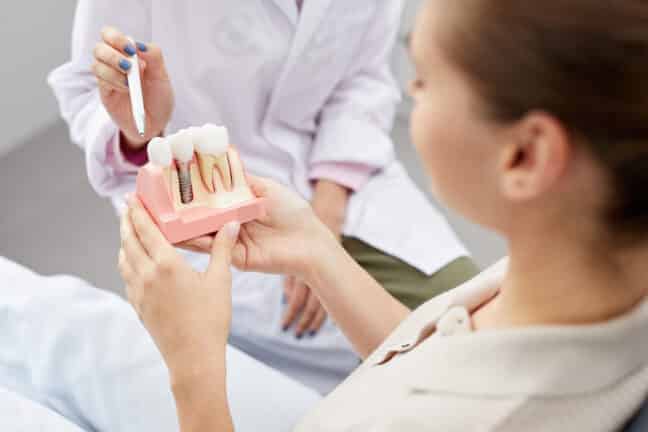What are Dental Implants?
Prior to the development of dental implants, only dentures and bridges could replace a missing tooth or teeth. Today, dental implants are considered the standard of care for replacing missing teeth. Most dental implants are made of titanium and are designed to provide anchorage for new teeth. In some cases, another type of implant made of a titanium-zirconium alloy is used because of its increased strength and smaller size.
Advantages of Dental Implants
- Implants look, feel and function like natural teeth
- Implants can restore a youthful appearance to your face and smile
- Compared to removable dentures, implants provide improved speech, comfort and eating
- Eliminates the need to drill into healthy teeth to support a bridge
- Prevents jawbone atrophy- the jawbone naturally shrinks over time when teeth are missing
- Implants will not decay and are much more resistant to periodontal disease than natural teeth
Am I a Candidate for Dental Implants?
Among the most significant criteria for determining whether dental implants are appropriate for an individual is the quality and quantity of jawbone where the implant is to be inserted. In addition, parts of the anatomy, such as large nerves, blood vessels or the maxillary sinus, could interfere with positioning the implant in the most ideal location.
If an anatomic obstruction exists at the dental implant’s intended location, or if the site lacks sufficient bone, we can perform a variety of procedures to overcome this obstacle. These procedures are discussed further below.
Proper treatment planning may involve advanced radiographic imaging, such as CT scans or Cone-beams. Once the 3-D images, x-rays, casts of your teeth and photographs have been reviewed, we devise a customized treatment plan to restore your oral health and your smile and present it to you.
While the success rate for dental implants is very high, certain pre-existing conditions can reduce their success, such as heavy cigarette smoking and poorly controlled diabetes.
Will I Have Teeth While the Implants are Healing?
It is very rare for a patient to leave our office without temporary teeth to replace missing teeth. Depending on the state of a patient’s dentition, temporary teeth may be fixed (cemented or bonded into place) or removable.
The doctors will ensure that their patients’ mouths look and feel natural. In certain situations, especially when the front teeth are involved and esthetics are a concern, the doctors may provide temporary teeth anchored directly to the implants on the same day that the implants are placed into the jawbone. Once the implant has healed the final restoration can commence.
Are There Any Disadvantages to Dental Implant Therapy?
In rare cases, the anticipated esthetic result associated with implants may make alternative treatment options more desirable.
The healing period required for the implant to integrate with the jawbone can vary from 3-6 months. However, during this integration period, the patient will likely have temporary teeth.
The jawbone may require augmentation prior to implant placement, which can delay the completion of treatment by up to 9 additional months.
A Worthy Investment
Implant dentistry is among the most predictable, natural looking, long-lasting and successful of all dental modalities.
Implants typically outlast fillings, root canals and crowns by many years. The return on your investment is high.
Implant Treatment
The Surgical Procedure
Inserting the Implant into the Jawbone
Part of the implant structure is designed to replace the root of the missing tooth and to support new teeth. This cylindrical shaped structure, composed of medical grade titanium or a titanium-zirconium alloy for added strength, is inserted into the jawbone beneath the gums.
During the 3-6 month healing period the implant fuses with the jawbone. This process is called osseointegration.
Typically, dental implant surgery is minimally invasive and is performed under an equal or less amount of local anesthesia than is given to a patient during a routine filling or root canal procedure. Laser-assisted implant surgery provides the additional benefits of improved healing, comfort and a quicker recovery. Sedation is also available to our patients. Our patients’ comfort is of the utmost importance to us.
Patients may return to work and resume most normal daily activities on the same day as surgery.
The Restorative Procedure
What will my new teeth look like?
The visible portion of the implant structure that looks like a tooth is called the implant crown. Implants can also be utilized to enhance and support removable teeth. Treatment options vary, depending on esthetics, the number of missing teeth and their location, and the patient’s vision. The patient’s options will be discussed in detail during your consultation visit
Related Procedures
Tissue Engineering
Have you been told by other dentists that you may lack sufficient bone or that your bone is too weak for implants? Has anyone told you that you may require bone to be harvested from somewhere else in your body such as the hip or chin?
The conditions at a site intended for a dental implant may not be ripe for implant placement if the quality or quantity of jawbone is not sufficient. The site can be prepared for such placement by applying one of several methods available to regenerate bone and gums, such as bone grafts, ridge expansion and sinus augmentation.
NY Laser Institute
The Waterlase YSGG advanced laser system represents such a significant breakthrough in the practice of periodontics, esthetic and implant dentistry, that we have devoted an entire website to this cutting-edge method of treatment.
Extractions
Dental implants replace missing teeth or existing teeth that require replacement. When teeth are extracted in anticipation of implant placement, the space which remains in the jawbone often requires a graft in order to preserve the surrounding bone and improve the healing response.
Sometimes, however, the implant can be placed directly into the unoccupied space. In some cases, a combination of grafting and simultaneous implant placement may be the best course of action.

